In the Web 1.0 days, the world was transformed by the introduction of online businesses. Although many of them ended up as spectacular flame outs, many business models have been reincarnated in the Web 2.0 world. Group buying from Mercata and Mobshop are now Groupon and LivingSocial. Online grocery shopping with Webvan didn’t work out, but today you can buy groceries online via Peapod. Scanning print ads for more information with the CueCat was short lived, but now print ads include QR codes with links to more information online. Some businesses like eBay, Amazon, and Craigslist thrived, while others like Napster pivoted their models in order to survive. The sector that drew the most media attention were the portals: AOL, Excite, Altavista, Lycos, Yahoo, Google, among others. Some referred to the dot-com boom as the “Information Revolution” or the “Digital Revolution” — but hindsight now shows us that 1996 – 2001 was only a small preview of what was possible and what was to come.
All of these 1.0 businesses had something in common: they did not create consumer products and were not end users; instead, they played a facilitation role to connect sellers to buyers, writers to readers, and producers to consumers. Their models were designed to reduce the friction of traditional commerce and monetize units of activity through direct and indirect participants, e.g. buyers and sellers or advertisers. The most successful companies inserted themselves as a welcome virtual wedge between two parties; welcome, because the new middlemen were faster and frictionless compared to the old ones.
As the Web 2.0 world has started to reach maturity, big data has exponentially expanded the opportunity available to digital middlemen. The social web shows us what’s available from a connected world, beyond simply accelerating sales processes of brick-and-mortar stores. Predictive analytics, semantic connections, and the internet of things enable emergent possibilities for improving individual lives and revealing new opportunities for commercial business models.
We are nearing the end of the early days of Web 2.0 and the Information Revolution is now truly upon us. And just as we saw a small group of leaders break away from the digital peloton at the end of Web 1.0, a small group is making a move to emerge on top of this current market. The key consideration this time around isn’t user eyeballs — it’s ownership of the user experience. Why does that matter? Users create content in many different forms: by recording and transmitting text, such as a tweet or product review; by engaging in online activities, such as clicking a like button or having a cookie from an advertising network store surfing behavior; or through physical activity that is digitally recorded, such as logging on to a computer or walking around with a GPS-enabled device.
“Owning” the user experience is easier said than done; these platforms require massive capital investment in platforms and brand building. Three early leaders exist in today’s race to own the experience ecosystem and its underlying big data assets: Apple, Google, and Microsoft. Each company has created pathways to offer hardware and software, the platforms of digital value creation. Competition is evolving around six key platforms: browsers, operating systems, peer-to-peer messaging, mobile devices, inquiry data, and personally identifiable information (PII). To see a graphic estimate of competitive positioning, see Figure 1. 
- Microsoft has never received a lot of love from the Web 2.0 world. However, it has a huge installed base of users and its bases are covered with key offerings: Internet Explorer, Windows, MSN Messenger, Nokia/Windows Mobile (and the new Surface), and Bing. Microsoft doesn’t have a strong source of PII (Passport isn’t/wasn’t the answer) and could use help with mobile devices and its browser.
- Google‘s broad range of experiments may be confusing to consumers, but there’s a method to the company’s madness. Chrome, Chrome OS, gChat, Android, Search, and Google+ complete a formidable offering. Emerging offerings like self-driving cars, Google Voice, and fiber optic networks hint at the totality of what Google has in mind when owning the Experience Ecosystem.
- Apple operates Safari, OS X, iMessage, and iPhone/iPad. Although they have no search engine and Ping is a niche experience, the dominance of its existing components can’t be denied.
- Two companies sit at the head of the pack that could easily join these three. Facebook may only have user PII, but they have over 900 million active users worth of it as well as a mountain of cash to get competitive quickly via acquisition, for example by buying or building a browser or search engine. Amazon faces an uphill battle with consumer devices and its OS, but it houses loads of user data from consumer transactions, the infrastructure of AWS/S3, and the A9 search engine still exists.
- Yahoo!, RIM/Blackberry, HP, and AOL all had their chances at one point in time, but seem unlikely to join the breakaway pack.
As competition between ecosystems grows more intense, the ability to normalize and compare data across increasingly closed platforms will present an integration challenge. Application providers will face the biggest challenge, needing to make their services interoperable across platforms. That’s why an innovative company like Facebook, now flush with cash, needs to get competitive quickly to compete in the new world order. Otherwise, it risks becoming beholden to one of the big three gatekeepers for long-term success.
The race to own the future is on. Open and closed are merely a matter of perspective and competitive positioning. Brands must choose carefully and hedge their bets by working across emerging ecosystems.
Credits to Rachel Meyerson for research support and Scott Matthews for graphic assistance.

HP????
Android is mobile hardware? I could have sworn it was an OS…
Mobile OS. Thanks for the comment!
No worries. I promise to be more constructive next time… 😉